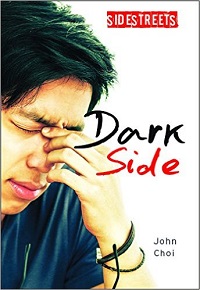| ________________
CM . . .
. Volume XXIII Number 18. . . .January 20, 2017
excerpt:
Emerson Yeung’s life looks good from the outside. He has some close friends, does well in school, has two parents who work hard to provide for the family, and a part-time job working at the family dry-cleaning business. Unfortunately for Emerson, looks can be deceiving. Despite the fact that he does well in school, his achievements never seem to be good enough to please his overbearing parents. His parents want him to be the perfect son, which leaves him juggling his job at the store and studying for his classes, with very little time left over to relax and be a teenager. Emerson tries his best to live up to his parents’ expectations, but he always feels like he falls short, leaving him exhausted and his parents perpetually disappointed. His deep, dark secret is that he has been having suicidal thoughts and feeling depressed for many years. Emerson’s life spirals out of control when his phone is stolen and the thieves post racist and threatening messages about staff members at his school. The police come to speak to Emerson, but sadly, he is more scared of his parents’ reactions than the questions the police have for him. As the stresses of life and his parents’ constant disapproval and abuse come to a climax, Emerson considers taking matters into his own hands and ending his life. Despite being very tired all the time, Emerson’s thoughts and anxieties keep him up at night, roaming the city after his parents go to sleep. On one of his excursions, he meets a girl, Max, whom he suspects is trying to commit suicide. Can this new friendship possibly be enough to save both of their lives? Dark Side is part of Lorimer’s “SideStreets” series. “SideStreets” is a high interest collection of teen fiction with reading levels between 3.0 and 5.5. The books are relatively short in length and are written with the intent of engaging “beginning” readers and even the most reluctant students with their relatable real-life topics and authentic characters. The books in the series contain short chapters, action-packed plotlines, large print, and straightforward vocabulary with the intent of attracting and maintaining readers’ attention. This book explores some serious themes that are relevant to teens’ lives. Dark Side examines the ideas of identity, family, friendship, abuse, suicide, depression, and the mental health system. It demonstrates the importance of communication within families and shows readers an example of what unhealthy family relationships may look like. It also shows readers the value of talking to someone when you are feeling stressed, depressed, anxious, or suicidal. Although all of these themes are quite serious, the book is not written in a graphic or overly detailed manner, and so it is a good one to introduce readers to these topics or to use as a classroom read-aloud before exploring some of these ideas further. Dark Side sets itself up as a fast-paced read right from the beginning. The plot gains momentum in the first few pages as readers see inside Emerson’s unhealthy family situation and the stress it causes him. The book’s chapters have straightforward titles that give readers an idea of what to expect and which support them in making predictions regarding the content of each chapter. Emerson is a realistic character with whom readers are likely to connect because they or someone they know may have been in a similar situation with feeling overwhelmed with school and life at some point. Dark Side has many characteristics that will appeal to a variety of young adult readers. The realistic and engaging content, relatable characters, and fast-moving plot will be of interest to reluctant readers, beginning readers, and strong readers looking for a quick, interesting read. The book is likely to encourage readers to think critically about mental health and healthy family relationships. Dark Side is an engaging read that covers many serious issues which will hold appeal to a wide audience of teen readers. Highly Recommended. Chasity Findlay is a high school English teacher and a graduate student at the University of Manitoba.
To comment
on this title or this review, send mail to cm@umanitoba.ca.
Copyright © the Manitoba Library Association. Reproduction for personal
use is permitted only if this copyright notice is maintained. Any
other reproduction is prohibited without permission.
Next Review | Table of Contents For This Issue - January 20, 2017 |
